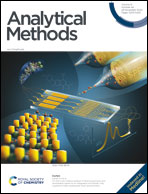Complexation–association–extraction spectrophotometric determination of Pt cations based on a multi-reagent analytical system with I− anions and 2-[2-[4-[(2-cyanoethyl)methylamino]phenyl]vinyl]-1,3,3-trimethyl-3H-indolium cations
Abstract
A new multi-reagent analytical system with 2-[2-[4-[(2-cyanoethyl)methylamino]phenyl]vinyl]-1,3,3-trimethyl-3H-indolium chloride (CPVTI), which is a styryl hemicyanine cationic dye with good photostability and a high molar absorption coefficient, as its core is first established and utilized successfully to determine the content of Pt ions via a spectrophotometric method. The process involves two treatment steps: adding CPVTI and I solutions to the Pt solution to be detected, and then using butyl acetate for vortex liquid–liquid extraction. A Pt cation can be incorporated into the CPVTI cation with the help of an I− anion, initially converting the Pt cation into a [PtI6]2− complex anion. After forming a [PtI62−·2CPVTI+](aq) ion associate in the aqueous phase, the Pt cation can be extracted selectively by butyl acetate with maximum extraction efficiency, and exists as [PtI62−·2CPVTI+](org) in the extract phase. Via the formation of the iodo-complex of Pt and its ion associate with CPVTI, and the extraction with butyl acetate, Pt is selectively partitioned into the butyl acetate extractant in a step-by-step manner with good interference resistance. In the CPVTI–Pt–I analytical system, the charge state of CPVTI is retained by adjustment with H2SO4; the monovalent CPVTI+ presents a strong spectrophotometric absorbance signal at 530 nm with long-term stability, which allows determination of the Pt content. The system shows a high molar absorption coefficient of 6.52 × 104 L mol−1 cm−1 at 530 nm, a lower limit of detection of 0.07 mg L−1, and a good Sandell's sensitivity of 0.0030 μg cm−2. Mechanistic analysis of the establishment of the system, concentration optimization, standard working curve, system sensitivity and stability, resistance against interference from diverse metal ions, and practical applications are investigated and discussed.
![Graphical abstract: Complexation–association–extraction spectrophotometric determination of Pt cations based on a multi-reagent analytical system with I− anions and 2-[2-[4-[(2-cyanoethyl)methylamino]phenyl]vinyl]-1,3,3-trimethyl-3H-indolium cations](/en/Image/Get?imageInfo.ImageType=GA&imageInfo.ImageIdentifier.ManuscriptID=D0AY01647K&imageInfo.ImageIdentifier.Year=2020)


 Please wait while we load your content...
Please wait while we load your content...